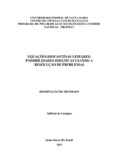| dc.creator | Campos, Adilson de | |
| dc.date.accessioned | 2016-06-27 | |
| dc.date.available | 2016-06-27 | |
| dc.date.issued | 2015-03-13 | |
| dc.identifier.citation | CAMPOS, Adilson de. Linear diophantine equations: teaching possibilities through problem solving. 2015. 89 f. Dissertação (Mestrado em Matemática) - Universidade Federal de Santa Maria, Santa Maria, 2015. | por |
| dc.identifier.uri | http://repositorio.ufsm.br/handle/1/10945 | |
| dc.description.abstract | This work presents an educational experiment carried out in a 9th grade class of elementary school, in order to assess the didactic and pedagogical possibilities involving the Linear Diophantine Equations theme, with the contextual support of Problem Solving. This application intends to expand the students' conceptions in arithmetic and algebra courses, also providing a concrete possibility of applicability of the greatest common divisor of two integers, a very neglected theme throughout the elementary school. In a level of elementary school, one of the main vehicles that allows you to work the initiative, creativity and exploring spirit is through Problem Solving. A Mathematics Teacher has a great opportunity to challenge the curiosity of the students by presenting them problems that are compatible with their knowledge and guiding them through incentive questions and this teacher can also try to input on them a taste for discovery and independent thinking. Thus, a very reasonable way is to prepare the student to deal with new situations, whatever they may be. The paper is organized in three chapters. In the first chapter entitled "Problem Solving in mathematics teaching" a theoretical foundation on the Teaching of Problem Solving is searched based on the Hungarian-American author George Polya and Luiz Roberto Dante and, it also presents some aspects from the learning theory proposed by Vygotsky. In the second chapter entitled "arithmetic concepts" the themes treated are: Greatest Common Divisor (gcd), Euclidean algorithm, Bèzout theorem and Linear Diophantine Equations. In the third and final chapter entitled "pedagogical experimentation" as mentioned above, the experimentation in a class of ninth grade of an elementary school. This experiment is based on the Didactic Engineering methodology, comprising the following stages: theme and scope of action; previous analyzes associated with the dimensions: epistemological, didactic and cognitive; prior analysis; experimentation; aftermost analysis and validation of Didactic Engineering. | eng |
| dc.description.sponsorship | Coordenação de Aperfeiçoamento de Pessoal de Nível Superior | |
| dc.format | application/pdf | por |
| dc.language | por | por |
| dc.publisher | Universidade Federal de Santa Maria | por |
| dc.rights | Acesso Aberto | por |
| dc.subject | Equações diofantinas lineares | por |
| dc.subject | Resolução de problemas | por |
| dc.subject | Algoritmo de Euclides | por |
| dc.subject | Linear diophantine equations | eng |
| dc.subject | Problem solving | eng |
| dc.subject | Euclidean algorithm | eng |
| dc.title | Equações diofantinas lineares: possibilidades didáticas usando a resolução de problemas | por |
| dc.title.alternative | Linear diophantine equations: teaching possibilities through problem solving | eng |
| dc.type | Dissertação | por |
| dc.description.resumo | Este trabalho apresenta uma experimentação pedagógica realizada numa turma de 9ºano do Ensino Fundamental com o objetivo de aferir as possibilidades didático-pedagógicas envolvendo a temática Equações Diofantinas Lineares, tendo como suporte contextual a Resolução de Problemas. Tal aplicação tem o intento de ampliar as concepções dos alunos nos campos da aritmética e da álgebra, dando também uma possibilidade concreta de aplicabilidade do máximo divisor comum de dois números inteiros, tema tão negligenciado ao longo do Ensino Fundamental. Em um nível de Ensino Fundamental, um dos principais veículos que permite trabalhar a iniciativa, a criatividade e o espírito explorador é a Resolução de Problemas. O professor de Matemática tem, dessa forma, uma grande oportunidade de desafiar a curiosidade de seus alunos, apresentando-lhes problemas compatíveis com os conhecimentos destes e orientando-os através de indagações incentivadoras, podendo incutir-lhes o gosto pela descoberta e pelo raciocínio independente. Assim, um caminho bastante razoável é preparar o aluno para lidar com situações novas, quaisquer que sejam elas. O trabalho está organizado em três capítulos. No primeiro capítulo intitulado A Resolução de Problemas no ensino da Matemática busca-se uma fundamentação teórica sobre a Didática da Resolução de Problemas no autor húngaro-americano George Polya e Luiz Roberto Dante e, também, são apresentados alguns aspectos da teoria da aprendizagem proposta por Vygotsky. No segundo capítulo intitulado conceitos de aritmética são tratados os temas: Máximo Divisor Comum (mdc), Algoritmo de Euclides, Teorema de Bèzout e Equações Diofantinas Lineares. No terceiro e último capítulo intitulado experimentação pedagógica é apresentada a experimentação supracitada numa turma de nono ano do Ensino Fundamental. Tal experimentação é baseada na metodologia Engenharia Didática, compreendendo os seguintes momentos: tema e campo de ação; análises prévias associadas às dimensões: epistemológica, didática e cognitiva; análise a priori; experimentação; análise a posteriori e validação da Engenharia Didática. | por |
| dc.contributor.advisor1 | Fusieger, Pedro | |
| dc.contributor.advisor1Lattes | http://lattes.cnpq.br/0662696868729944 | por |
| dc.contributor.advisor-co1 | Roos, Liane Teresinha Wendling | |
| dc.contributor.advisor-co1Lattes | http://lattes.cnpq.br/9093687996155230 | por |
| dc.contributor.referee1 | Bittencourt, Fidelis | |
| dc.contributor.referee1Lattes | http://lattes.cnpq.br/8222657444317759 | por |
| dc.contributor.referee2 | Noguti, Fabiane Cristina Höpner | |
| dc.contributor.referee2Lattes | http://lattes.cnpq.br/1247690905207985 | por |
| dc.creator.Lattes | http://lattes.cnpq.br/3935941057935045 | por |
| dc.publisher.country | BR | por |
| dc.publisher.department | Matemática | por |
| dc.publisher.initials | UFSM | por |
| dc.publisher.program | Programa de Pós-Graduação em Matemática em Rede Nacional | por |
| dc.subject.cnpq | CNPQ::CIENCIAS EXATAS E DA TERRA::MATEMATICA | por |


